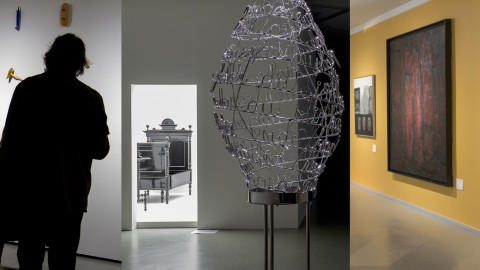Landscape experiences
June 17–Oct 23 Holvi
The Jyväskylä Art Museum’s summer exhibition brings attention to the works of our national artists Akseli Gallen-Kallela (1865–1931) and Pekka Halonen (1865–1933) made in Central Finland, and shows the artists as an integral part of their era, in which the concept of the “Finnish landscape” was born.
The importance of Central Finland, in the formation of the Finnish landscape, is rarely discussed. However, during the turn of the 20th century, this area was considered an untouched region of authentic Finland where many artists travelled on painting excursions, in search of original nature, country folk and living conditions.
Pekka Halonen and Akseli Gallen-Kallela captivated by Central Finnish landscape
For Pekka Halonen, merely travelling to Central Finland was not enough, and so from 1916, he began spending his summers in Kuhmoinen, where he had already painted in the beginning of the 1910’s. He fell in love with the old growth forests and rivers of Central Finland. The rocky shores of Lake Päijänne are also represented in his paintings. Halonen spent the summer in Kumoinen until the year he died in 1933. Before moving to Kuhmoinen, Halonen had never really painted summer landscapes because he felt the abundance of green was too monochromatic and “spinach-like”. The natural light and mist from the rapids in Kivikoski helped him see summer in a whole new way; ever changing and rich in nuance.
Akseli Gallen-Kallela first turned his regard toward Central Finland in 1884 when, as a student, he went on a painting excursion to Keuruu. He travelled to Central Finland for the last time in 1930. While Halonen painted the rocky rivers with their pools of still water, and the steep hills of Kuhmoinen, Gallen-Kallela zigzagged across Central Finland. Gallen-Kallela painted snow covered pines, the ripples and billowing clouds on the surface of the water, and the everyday folk life. People were a part of nature and the forms of nature served to enhance the narration of his paintings, as in his work Kullervon kirous (1899) shown in this exhibition.
Gallen-Kallela and Halonen converge with contemporary art
Landscape and the environment are frequently present in contemporary art: photography, media art and painting. By converging the work of two national artists with contemporary art, a historically informative and critical perspective on the environment, landscape and how they are represented, is created. The viewer is invited to deconstruct and consider the cultural aspects of landscape as well as the figurativeness of landscape.
The modern day individual is often lost or estranged in the natural landscape. Nature is like a reserve, a place we visit or try something new. The landscape of contemporary art can also be urban, constructed environment, or an inner landscape. The concept of landscape is very vast and includes cityscapes which are more familiar to many of us than wild forests, rippling grain fields or glistening lakebeds.
This exhibition expresses opinions about nature and the contemporary state of the environment, and studies the relationship between humans and nature from as much positive as negative perspectives. Landscape can be used to mirror the obscured side of society, as in the work by Ari Saarto, or landscape can be used to study urbanization, as in the work by Thomas Nyqvist. Jan Eerala, Ilkka Halso and Juha Suonpää express a concern for the contemporary state of the environment. Hannaleena Heiska, Elina Brotherus and Kari Soinio consider the relationship between humans and nature, and Antti Laitinen uses humour to represent people in nature. Moving through landscape is also an important part of the exhibition. Pekka Luukkola, Jussi Niva, Tuula Närhinen and Markus Konttinen all take a different perspective on movement. Jorma Puranen and particularly Jarmo Kukkonen contemplate reflections, inner landscapes and other landscape concepts.
Landscape Experiences shows the importance of Central Finland
The objective, of the Landscape Experiences project, is to bring attention to new perspectives and different ways of interpreting our environment, the golden age landscape painting and contemporary art. The formation and transformation of our relationship to nature, as well as the way nature is treated through the visual arts, is part of the focus of this study. The intention of this project is to show the importance of Central Finnish landscape within the landscape tradition and to provoke thought about the relationship between landscape and our environment as well as the whole experience of the environment.
In addition to the Landscape Experiences exhibition, the project includes two publications: a book and an Internet publication. The Landscape Experiences book, published by the Maahenki publishing company, features texts by university researchers of landscape and the environment, from different scientific fields, who express different perspectives on the significance of landscape. The Internet publication is devised for students, and features educational material and a picture gallery of the exhibition. These pages also include other material about landscape and the environment. The Landscape Experiences book includes a summary of the books topic in English.
The Landscape Experiences seminar is taking place on the 13th of October.
The programme in Finnish: http://www.jyvaskyla.fi/taidemuseo/tunnemaisemaseminaari
Jyväskylä Art Museum, Kauppakatu 23, Tues – Sun, 11am – 6pm, admission 6/3 €
Exceptionally, there is no free admission to this exhibition on Fridays.
Notice: school groups will visit the exhibition August 30th – October 14th weekdays 12–13:30pm
Group tours can be reserved by telephone: (014) 266 4391 or email: [email protected].

